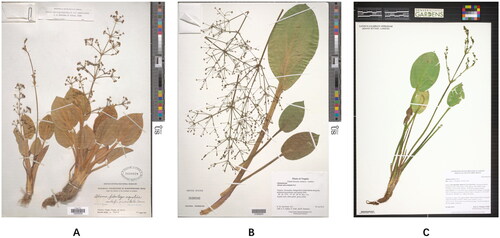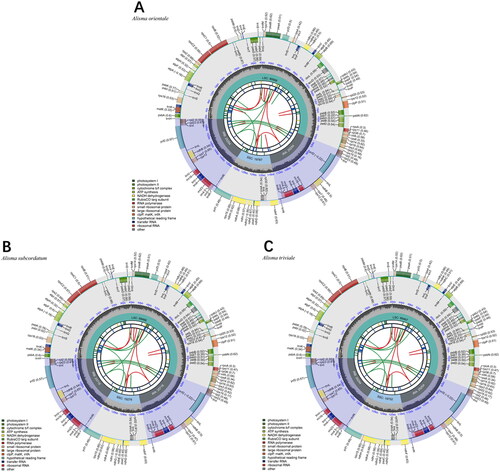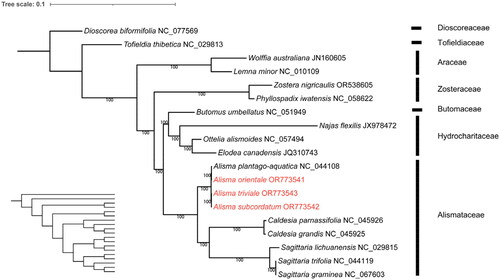Figures & data
Figure 1. Herbarium specimens used in the Alisma chloroplast genome analyses. All three specimens show complete stems, leaves, inflorescences, flowers, and the detailed information of collection and identification. Images of (A) A. orientale and (B) A. subcordatum are from the official website of the US National Herbarium (https://collections.nmnh.si.edu/search/botany/), and the use of the photos and specimens has been authorized by the Curator, Dr. Jun Wen; and (C) A. triviale from the official website of the Kathryn Kalmbach Herbarium of the Denver Botanic Gardens (https://swbiodiversity.org/seinet/collections/harvestparams.php), and the use of the photos and specimens has been authorized by the Curator Dr. Jennifer Ackerfield.

Figure 2. The chloroplast genome map of (A) A. orientale, (B) A. subcordatum, and (C) A. triviale. The map was generated by CPGView. Genes located on the inner and outer of circle are transcribed clockwise and anticlockwise, respectively. The dark grey inner circle indicates GC content. Large single-copy (LSC), small single-copy (SSC), and inverted repeats (IRA and IRB) are indicated in the inner layer. The functional classification of the genes is provided in the bottom left corner.

Figure 3. Maximum-likelihood (ML) phylogenetic tree of the order Alismatales based on the complete cp genomes of 18 species in the order, with Dioscorea biformifolia (Dioscoreaceae) as the outgroup. The scale bar represents the number of substitutions per site. The bootstrap method used was SH-aLRT. The number above the line represents ML bootstrap value. The specie names colored in red represent the three newly sequenced chloroplast genomes (Alisma orientale OR773541, A. subcordatum OR773542 and A. triviale OR773543). The following sequences were used: Dioscorea biformifolia NC_077569 (unpublished), Tofieldia thibetica NC_029813 and Sagittaria lichuanensis NC_029815 (Luo et al. Citation2016), Wolffia australiana JN160605 (Wang and Messing Citation2011), Lemna minor NC_010109 (Mardanov et al. Citation2008), Zostera nigricaulis OR538605 (unpublished), Phyllospadix iwatensis NC_058622 (Chen et al. Citation2021), Butomus umbellatus NC_051949 (Yang and Liu Citation2019), Najas flexilis JX978472 (Peredo et al. Citation2013), Ottelia alismoides NC_057494 (Guo et al. Citation2020), Elodea canadensis JQ310743 (Huotari and Korpelainen Citation2012), Alisma plantago-aquatica NC_044108 and Sagittaria trifolia NC_044119 (Liang et al. Citation2019), Sagittaria graminea NC_067603 (unpublished), and Caldesia parnassifolia NC_045926 and C. grandis NC_045925 (Mwanzia et al. Citation2019).

Supplemental Material
Download MS Word (1.9 MB)Data availability statement
The authors have deposited all the raw data in GenBank, which have all been activated. The data that support the findings of this study are openly available in GenBank at https://www.ncbi.nlm.nih.gov/ under the accession number OR773541, OR773542, and OR773543. The associated BioProject, SRA, and BioSample numbers are PRJNA1037010, SRX22416385 (Alisma orientale), SRX22416386 (Alisma subcordatum), SRX22416387 (Alisma triviale) and SAMN38155281 (Alisma orientale), SAMN38155282 (Alisma subcordatum), SAMN38155283 (Alisma triviale), respectively.
